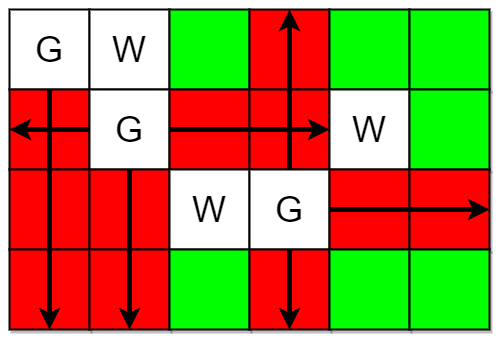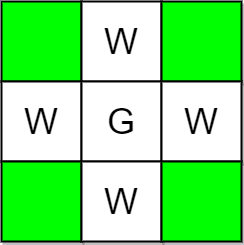public class Solution
extends Object
2257 - Count Unguarded Cells in the Grid\.
Medium
You are given two integers `m` and `n` representing a **0-indexed** `m x n` grid. You are also given two 2D integer arrays `guards` and `walls` where guards[i] = [rowi, coli] and walls[j] = [rowj, colj] represent the positions of the ith guard and jth wall respectively.
A guard can see **every** cell in the four cardinal directions (north, east, south, or west) starting from their position unless **obstructed** by a wall or another guard. A cell is **guarded** if there is **at least** one guard that can see it.
Return _the number of unoccupied cells that are **not** **guarded**._
**Example 1:**

**Input:** m = 4, n = 6, guards = \[\[0,0],[1,1],[2,3]], walls = \[\[0,1],[2,2],[1,4]]
**Output:** 7
**Explanation:** The guarded and unguarded cells are shown in red and green respectively in the above diagram. There are a total of 7 unguarded cells, so we return 7.
**Example 2:**

**Input:** m = 3, n = 3, guards = \[\[1,1]], walls = \[\[0,1],[1,0],[2,1],[1,2]]
**Output:** 4
**Explanation:** The unguarded cells are shown in green in the above diagram. There are a total of 4 unguarded cells, so we return 4.
**Constraints:**
* 1 <= m, n <= 105
* 2 <= m * n <= 105
* 1 <= guards.length, walls.length <= 5 * 104
* `2 <= guards.length + walls.length <= m * n`
* `guards[i].length == walls[j].length == 2`
* 0 <= rowi, rowj < m
* 0 <= coli, colj < n
* All the positions in `guards` and `walls` are **unique**.